UK & Australia: A Regulatory Environment Analysis of Accounting Theory
VerifiedAdded on 2023/06/14
|12
|4090
|117
Literature Review
AI Summary
This literature review examines the regulatory environments for financial reporting in Australia and the UK, focusing on perceived problems, how the environments operate, and progress toward IFRS adoption. It assesses the financial regulatory environment through the lens of Regulatory Capture Theory, explaining the theory's usefulness and characteristics indicating a captured regulatory environment. Key findings include challenges in IFRS implementation in Australia, such as lack of training, and technical breaches in UK term loans due to IFRS adoption. The review identifies the AASB as the Australian regulatory agency and details the UK GAAP framework, highlighting the five regimes available under FRS 102. The study concludes by emphasizing the importance of understanding regulatory capture theory and its potential impact on financial reporting.
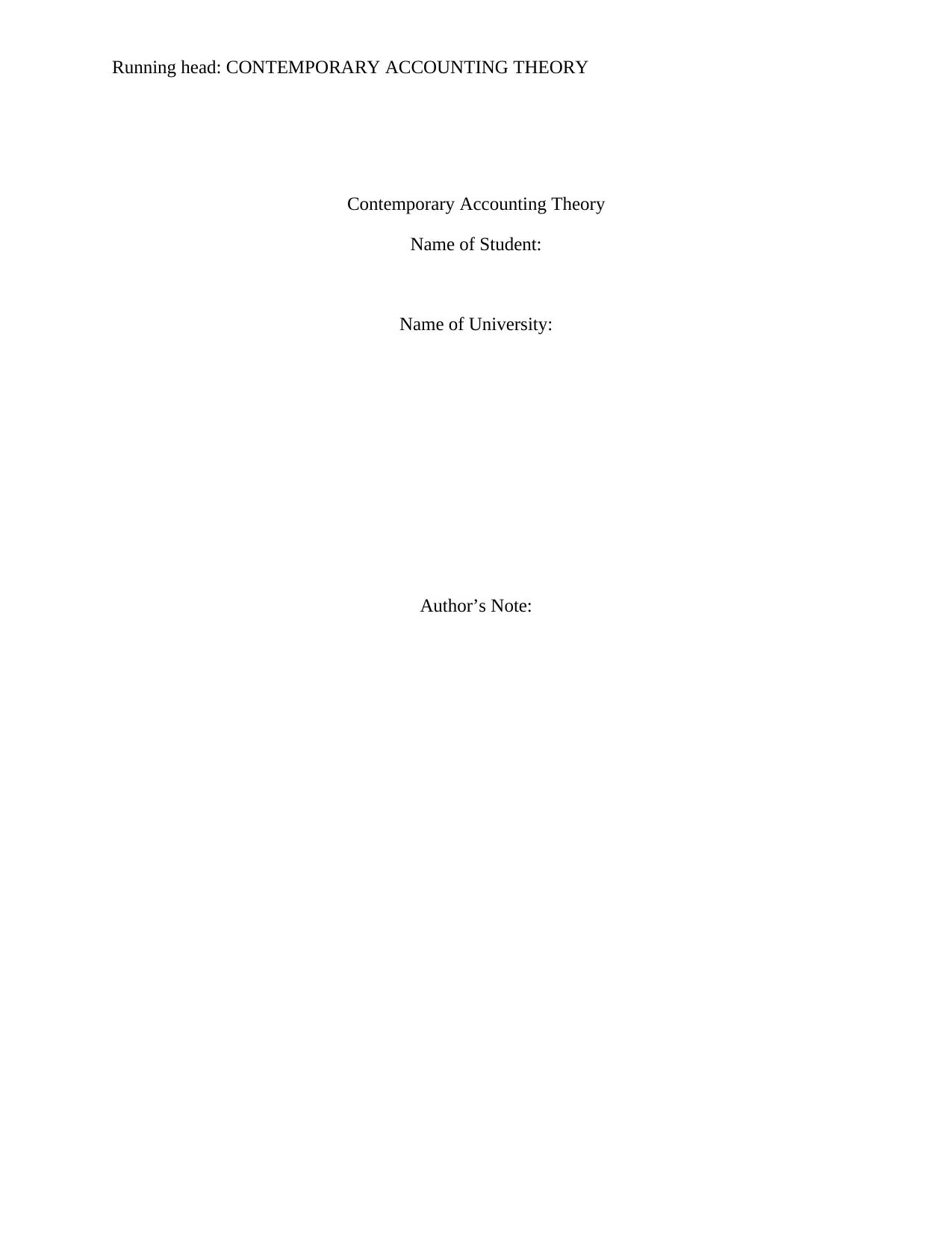
Running head: CONTEMPORARY ACCOUNTING THEORY
Contemporary Accounting Theory
Name of Student:
Name of University:
Author’s Note:
Contemporary Accounting Theory
Name of Student:
Name of University:
Author’s Note:
Paraphrase This Document
Need a fresh take? Get an instant paraphrase of this document with our AI Paraphraser
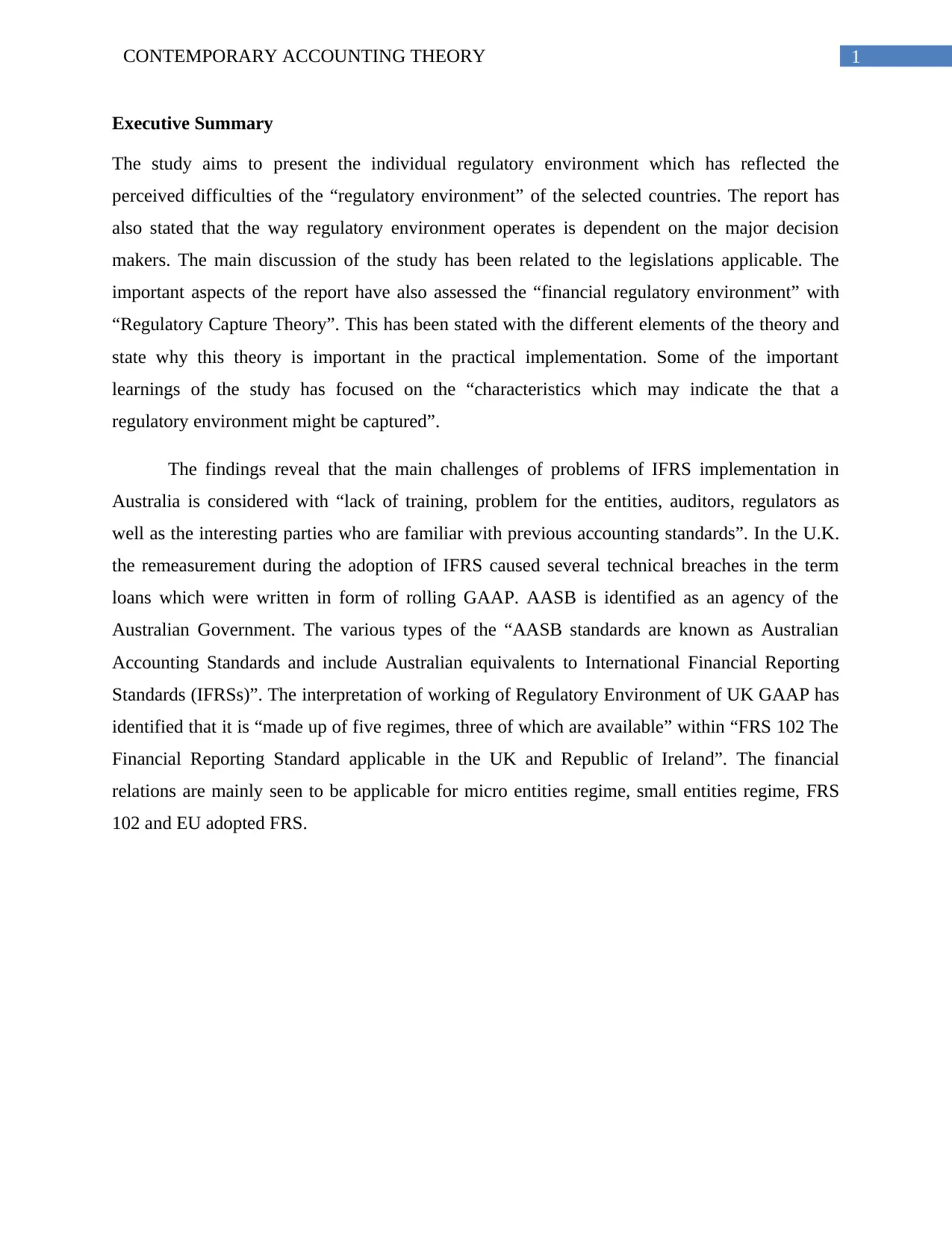
1CONTEMPORARY ACCOUNTING THEORY
Executive Summary
The study aims to present the individual regulatory environment which has reflected the
perceived difficulties of the “regulatory environment” of the selected countries. The report has
also stated that the way regulatory environment operates is dependent on the major decision
makers. The main discussion of the study has been related to the legislations applicable. The
important aspects of the report have also assessed the “financial regulatory environment” with
“Regulatory Capture Theory”. This has been stated with the different elements of the theory and
state why this theory is important in the practical implementation. Some of the important
learnings of the study has focused on the “characteristics which may indicate the that a
regulatory environment might be captured”.
The findings reveal that the main challenges of problems of IFRS implementation in
Australia is considered with “lack of training, problem for the entities, auditors, regulators as
well as the interesting parties who are familiar with previous accounting standards”. In the U.K.
the remeasurement during the adoption of IFRS caused several technical breaches in the term
loans which were written in form of rolling GAAP. AASB is identified as an agency of the
Australian Government. The various types of the “AASB standards are known as Australian
Accounting Standards and include Australian equivalents to International Financial Reporting
Standards (IFRSs)”. The interpretation of working of Regulatory Environment of UK GAAP has
identified that it is “made up of five regimes, three of which are available” within “FRS 102 The
Financial Reporting Standard applicable in the UK and Republic of Ireland”. The financial
relations are mainly seen to be applicable for micro entities regime, small entities regime, FRS
102 and EU adopted FRS.
Executive Summary
The study aims to present the individual regulatory environment which has reflected the
perceived difficulties of the “regulatory environment” of the selected countries. The report has
also stated that the way regulatory environment operates is dependent on the major decision
makers. The main discussion of the study has been related to the legislations applicable. The
important aspects of the report have also assessed the “financial regulatory environment” with
“Regulatory Capture Theory”. This has been stated with the different elements of the theory and
state why this theory is important in the practical implementation. Some of the important
learnings of the study has focused on the “characteristics which may indicate the that a
regulatory environment might be captured”.
The findings reveal that the main challenges of problems of IFRS implementation in
Australia is considered with “lack of training, problem for the entities, auditors, regulators as
well as the interesting parties who are familiar with previous accounting standards”. In the U.K.
the remeasurement during the adoption of IFRS caused several technical breaches in the term
loans which were written in form of rolling GAAP. AASB is identified as an agency of the
Australian Government. The various types of the “AASB standards are known as Australian
Accounting Standards and include Australian equivalents to International Financial Reporting
Standards (IFRSs)”. The interpretation of working of Regulatory Environment of UK GAAP has
identified that it is “made up of five regimes, three of which are available” within “FRS 102 The
Financial Reporting Standard applicable in the UK and Republic of Ireland”. The financial
relations are mainly seen to be applicable for micro entities regime, small entities regime, FRS
102 and EU adopted FRS.
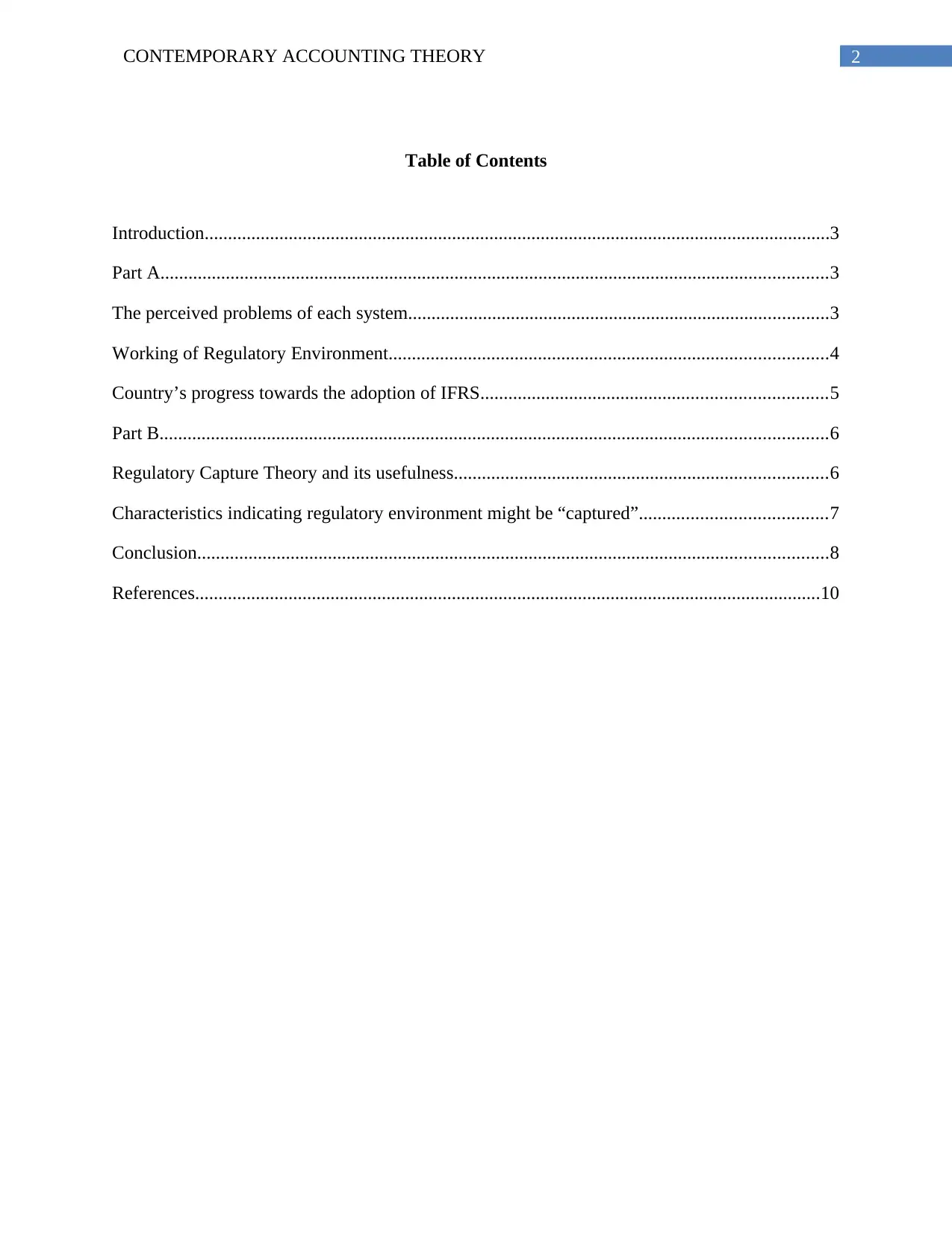
2CONTEMPORARY ACCOUNTING THEORY
Table of Contents
Introduction......................................................................................................................................3
Part A...............................................................................................................................................3
The perceived problems of each system..........................................................................................3
Working of Regulatory Environment..............................................................................................4
Country’s progress towards the adoption of IFRS..........................................................................5
Part B...............................................................................................................................................6
Regulatory Capture Theory and its usefulness................................................................................6
Characteristics indicating regulatory environment might be “captured”........................................7
Conclusion.......................................................................................................................................8
References......................................................................................................................................10
Table of Contents
Introduction......................................................................................................................................3
Part A...............................................................................................................................................3
The perceived problems of each system..........................................................................................3
Working of Regulatory Environment..............................................................................................4
Country’s progress towards the adoption of IFRS..........................................................................5
Part B...............................................................................................................................................6
Regulatory Capture Theory and its usefulness................................................................................6
Characteristics indicating regulatory environment might be “captured”........................................7
Conclusion.......................................................................................................................................8
References......................................................................................................................................10
⊘ This is a preview!⊘
Do you want full access?
Subscribe today to unlock all pages.

Trusted by 1+ million students worldwide
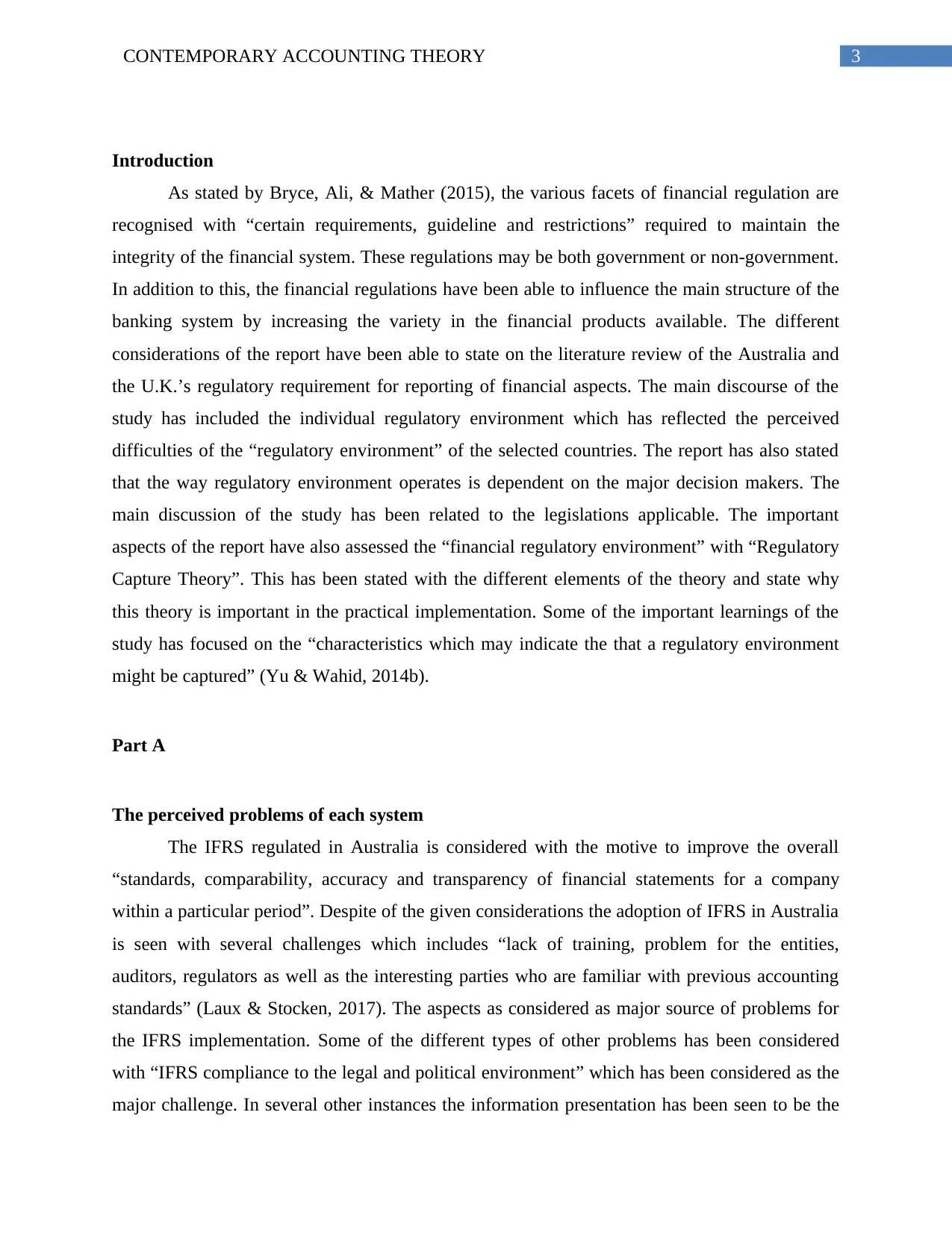
3CONTEMPORARY ACCOUNTING THEORY
Introduction
As stated by Bryce, Ali, & Mather (2015), the various facets of financial regulation are
recognised with “certain requirements, guideline and restrictions” required to maintain the
integrity of the financial system. These regulations may be both government or non-government.
In addition to this, the financial regulations have been able to influence the main structure of the
banking system by increasing the variety in the financial products available. The different
considerations of the report have been able to state on the literature review of the Australia and
the U.K.’s regulatory requirement for reporting of financial aspects. The main discourse of the
study has included the individual regulatory environment which has reflected the perceived
difficulties of the “regulatory environment” of the selected countries. The report has also stated
that the way regulatory environment operates is dependent on the major decision makers. The
main discussion of the study has been related to the legislations applicable. The important
aspects of the report have also assessed the “financial regulatory environment” with “Regulatory
Capture Theory”. This has been stated with the different elements of the theory and state why
this theory is important in the practical implementation. Some of the important learnings of the
study has focused on the “characteristics which may indicate the that a regulatory environment
might be captured” (Yu & Wahid, 2014b).
Part A
The perceived problems of each system
The IFRS regulated in Australia is considered with the motive to improve the overall
“standards, comparability, accuracy and transparency of financial statements for a company
within a particular period”. Despite of the given considerations the adoption of IFRS in Australia
is seen with several challenges which includes “lack of training, problem for the entities,
auditors, regulators as well as the interesting parties who are familiar with previous accounting
standards” (Laux & Stocken, 2017). The aspects as considered as major source of problems for
the IFRS implementation. Some of the different types of other problems has been considered
with “IFRS compliance to the legal and political environment” which has been considered as the
major challenge. In several other instances the information presentation has been seen to be the
Introduction
As stated by Bryce, Ali, & Mather (2015), the various facets of financial regulation are
recognised with “certain requirements, guideline and restrictions” required to maintain the
integrity of the financial system. These regulations may be both government or non-government.
In addition to this, the financial regulations have been able to influence the main structure of the
banking system by increasing the variety in the financial products available. The different
considerations of the report have been able to state on the literature review of the Australia and
the U.K.’s regulatory requirement for reporting of financial aspects. The main discourse of the
study has included the individual regulatory environment which has reflected the perceived
difficulties of the “regulatory environment” of the selected countries. The report has also stated
that the way regulatory environment operates is dependent on the major decision makers. The
main discussion of the study has been related to the legislations applicable. The important
aspects of the report have also assessed the “financial regulatory environment” with “Regulatory
Capture Theory”. This has been stated with the different elements of the theory and state why
this theory is important in the practical implementation. Some of the important learnings of the
study has focused on the “characteristics which may indicate the that a regulatory environment
might be captured” (Yu & Wahid, 2014b).
Part A
The perceived problems of each system
The IFRS regulated in Australia is considered with the motive to improve the overall
“standards, comparability, accuracy and transparency of financial statements for a company
within a particular period”. Despite of the given considerations the adoption of IFRS in Australia
is seen with several challenges which includes “lack of training, problem for the entities,
auditors, regulators as well as the interesting parties who are familiar with previous accounting
standards” (Laux & Stocken, 2017). The aspects as considered as major source of problems for
the IFRS implementation. Some of the different types of other problems has been considered
with “IFRS compliance to the legal and political environment” which has been considered as the
major challenge. In several other instances the information presentation has been seen to be the
Paraphrase This Document
Need a fresh take? Get an instant paraphrase of this document with our AI Paraphraser
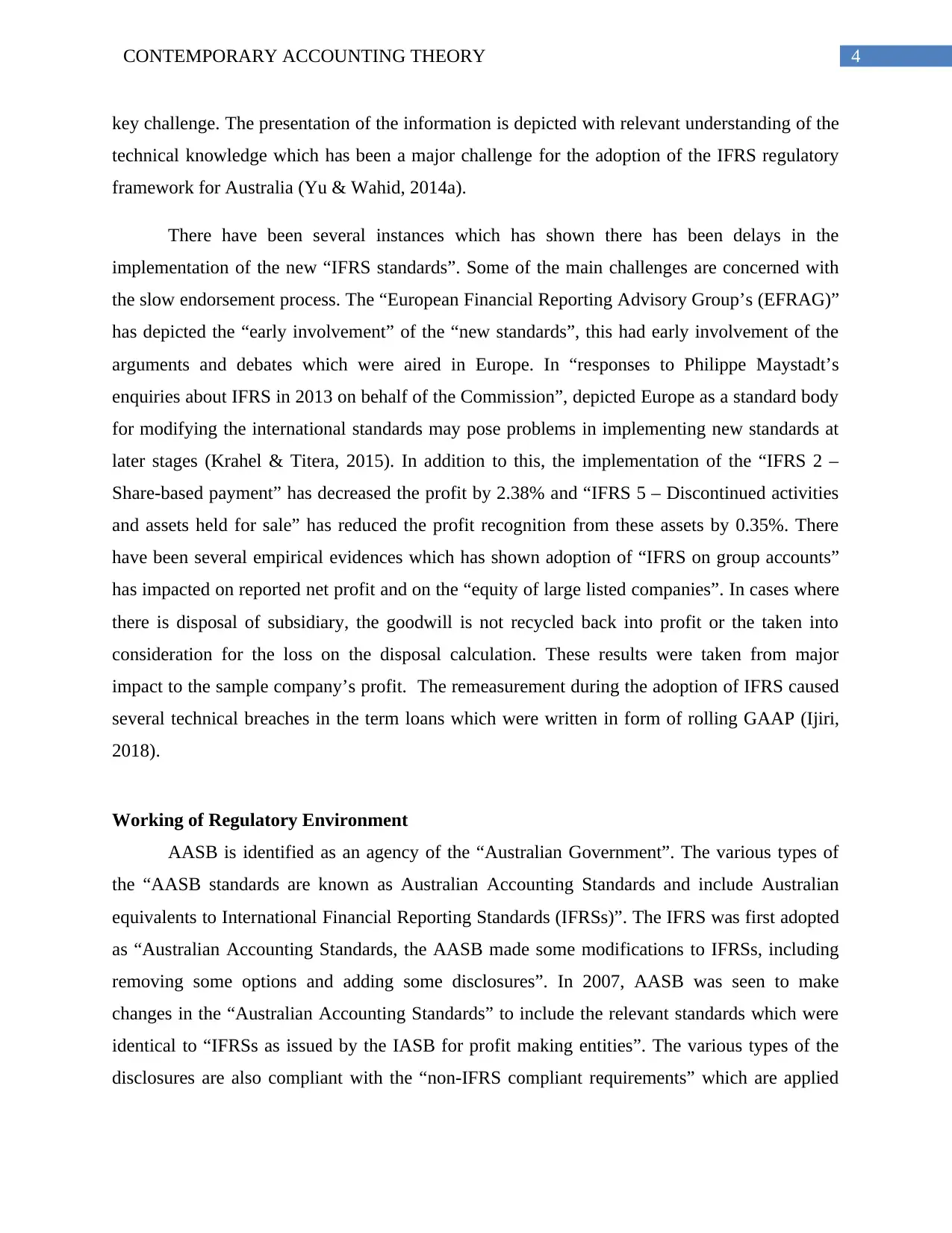
4CONTEMPORARY ACCOUNTING THEORY
key challenge. The presentation of the information is depicted with relevant understanding of the
technical knowledge which has been a major challenge for the adoption of the IFRS regulatory
framework for Australia (Yu & Wahid, 2014a).
There have been several instances which has shown there has been delays in the
implementation of the new “IFRS standards”. Some of the main challenges are concerned with
the slow endorsement process. The “European Financial Reporting Advisory Group’s (EFRAG)”
has depicted the “early involvement” of the “new standards”, this had early involvement of the
arguments and debates which were aired in Europe. In “responses to Philippe Maystadt’s
enquiries about IFRS in 2013 on behalf of the Commission”, depicted Europe as a standard body
for modifying the international standards may pose problems in implementing new standards at
later stages (Krahel & Titera, 2015). In addition to this, the implementation of the “IFRS 2 –
Share-based payment” has decreased the profit by 2.38% and “IFRS 5 – Discontinued activities
and assets held for sale” has reduced the profit recognition from these assets by 0.35%. There
have been several empirical evidences which has shown adoption of “IFRS on group accounts”
has impacted on reported net profit and on the “equity of large listed companies”. In cases where
there is disposal of subsidiary, the goodwill is not recycled back into profit or the taken into
consideration for the loss on the disposal calculation. These results were taken from major
impact to the sample company’s profit. The remeasurement during the adoption of IFRS caused
several technical breaches in the term loans which were written in form of rolling GAAP (Ijiri,
2018).
Working of Regulatory Environment
AASB is identified as an agency of the “Australian Government”. The various types of
the “AASB standards are known as Australian Accounting Standards and include Australian
equivalents to International Financial Reporting Standards (IFRSs)”. The IFRS was first adopted
as “Australian Accounting Standards, the AASB made some modifications to IFRSs, including
removing some options and adding some disclosures”. In 2007, AASB was seen to make
changes in the “Australian Accounting Standards” to include the relevant standards which were
identical to “IFRSs as issued by the IASB for profit making entities”. The various types of the
disclosures are also compliant with the “non-IFRS compliant requirements” which are applied
key challenge. The presentation of the information is depicted with relevant understanding of the
technical knowledge which has been a major challenge for the adoption of the IFRS regulatory
framework for Australia (Yu & Wahid, 2014a).
There have been several instances which has shown there has been delays in the
implementation of the new “IFRS standards”. Some of the main challenges are concerned with
the slow endorsement process. The “European Financial Reporting Advisory Group’s (EFRAG)”
has depicted the “early involvement” of the “new standards”, this had early involvement of the
arguments and debates which were aired in Europe. In “responses to Philippe Maystadt’s
enquiries about IFRS in 2013 on behalf of the Commission”, depicted Europe as a standard body
for modifying the international standards may pose problems in implementing new standards at
later stages (Krahel & Titera, 2015). In addition to this, the implementation of the “IFRS 2 –
Share-based payment” has decreased the profit by 2.38% and “IFRS 5 – Discontinued activities
and assets held for sale” has reduced the profit recognition from these assets by 0.35%. There
have been several empirical evidences which has shown adoption of “IFRS on group accounts”
has impacted on reported net profit and on the “equity of large listed companies”. In cases where
there is disposal of subsidiary, the goodwill is not recycled back into profit or the taken into
consideration for the loss on the disposal calculation. These results were taken from major
impact to the sample company’s profit. The remeasurement during the adoption of IFRS caused
several technical breaches in the term loans which were written in form of rolling GAAP (Ijiri,
2018).
Working of Regulatory Environment
AASB is identified as an agency of the “Australian Government”. The various types of
the “AASB standards are known as Australian Accounting Standards and include Australian
equivalents to International Financial Reporting Standards (IFRSs)”. The IFRS was first adopted
as “Australian Accounting Standards, the AASB made some modifications to IFRSs, including
removing some options and adding some disclosures”. In 2007, AASB was seen to make
changes in the “Australian Accounting Standards” to include the relevant standards which were
identical to “IFRSs as issued by the IASB for profit making entities”. The various types of the
disclosures are also compliant with the “non-IFRS compliant requirements” which are applied
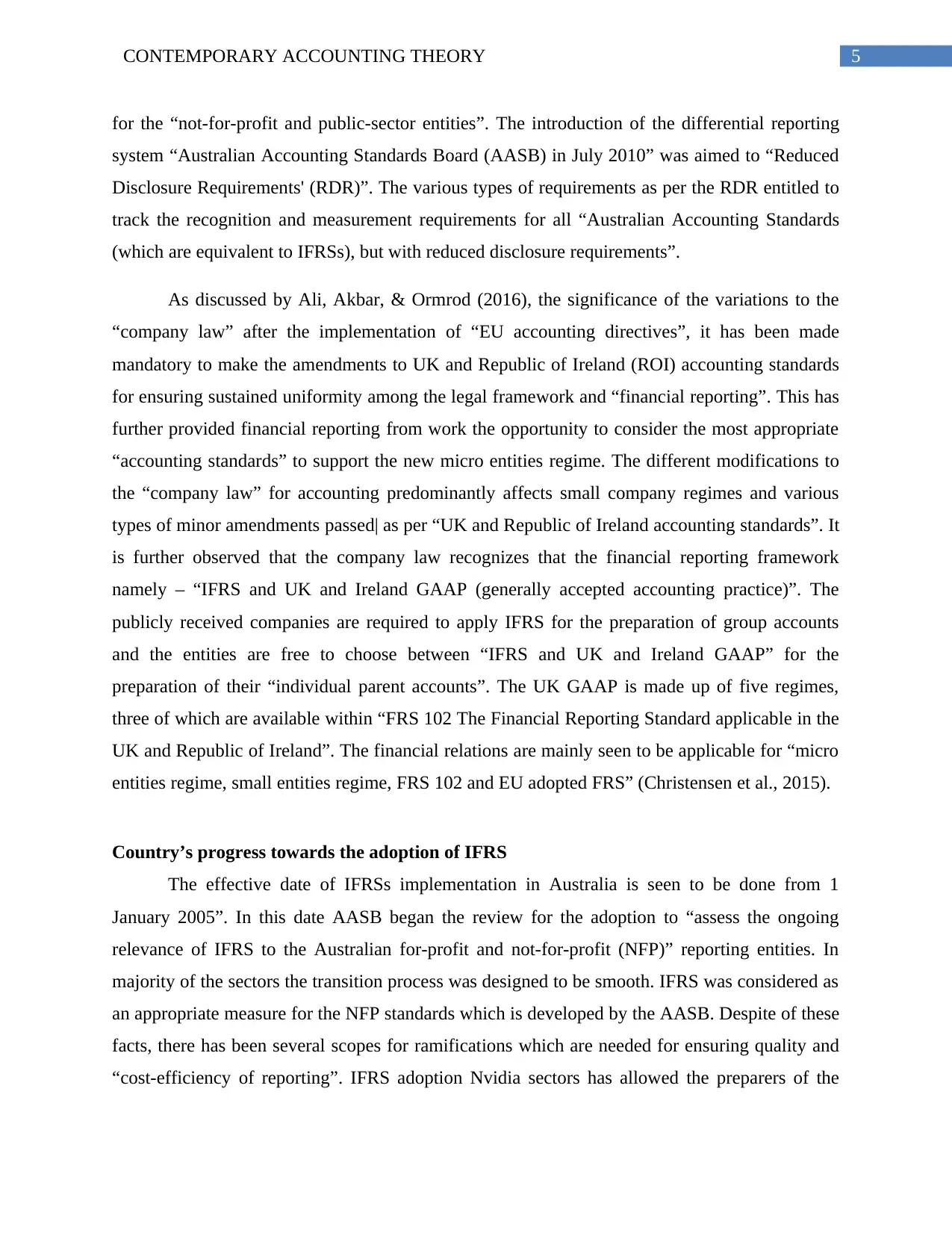
5CONTEMPORARY ACCOUNTING THEORY
for the “not-for-profit and public-sector entities”. The introduction of the differential reporting
system “Australian Accounting Standards Board (AASB) in July 2010” was aimed to “Reduced
Disclosure Requirements' (RDR)”. The various types of requirements as per the RDR entitled to
track the recognition and measurement requirements for all “Australian Accounting Standards
(which are equivalent to IFRSs), but with reduced disclosure requirements”.
As discussed by Ali, Akbar, & Ormrod (2016), the significance of the variations to the
“company law” after the implementation of “EU accounting directives”, it has been made
mandatory to make the amendments to UK and Republic of Ireland (ROI) accounting standards
for ensuring sustained uniformity among the legal framework and “financial reporting”. This has
further provided financial reporting from work the opportunity to consider the most appropriate
“accounting standards” to support the new micro entities regime. The different modifications to
the “company law” for accounting predominantly affects small company regimes and various
types of minor amendments passed| as per “UK and Republic of Ireland accounting standards”. It
is further observed that the company law recognizes that the financial reporting framework
namely – “IFRS and UK and Ireland GAAP (generally accepted accounting practice)”. The
publicly received companies are required to apply IFRS for the preparation of group accounts
and the entities are free to choose between “IFRS and UK and Ireland GAAP” for the
preparation of their “individual parent accounts”. The UK GAAP is made up of five regimes,
three of which are available within “FRS 102 The Financial Reporting Standard applicable in the
UK and Republic of Ireland”. The financial relations are mainly seen to be applicable for “micro
entities regime, small entities regime, FRS 102 and EU adopted FRS” (Christensen et al., 2015).
Country’s progress towards the adoption of IFRS
The effective date of IFRSs implementation in Australia is seen to be done from 1
January 2005”. In this date AASB began the review for the adoption to “assess the ongoing
relevance of IFRS to the Australian for-profit and not-for-profit (NFP)” reporting entities. In
majority of the sectors the transition process was designed to be smooth. IFRS was considered as
an appropriate measure for the NFP standards which is developed by the AASB. Despite of these
facts, there has been several scopes for ramifications which are needed for ensuring quality and
“cost-efficiency of reporting”. IFRS adoption Nvidia sectors has allowed the preparers of the
for the “not-for-profit and public-sector entities”. The introduction of the differential reporting
system “Australian Accounting Standards Board (AASB) in July 2010” was aimed to “Reduced
Disclosure Requirements' (RDR)”. The various types of requirements as per the RDR entitled to
track the recognition and measurement requirements for all “Australian Accounting Standards
(which are equivalent to IFRSs), but with reduced disclosure requirements”.
As discussed by Ali, Akbar, & Ormrod (2016), the significance of the variations to the
“company law” after the implementation of “EU accounting directives”, it has been made
mandatory to make the amendments to UK and Republic of Ireland (ROI) accounting standards
for ensuring sustained uniformity among the legal framework and “financial reporting”. This has
further provided financial reporting from work the opportunity to consider the most appropriate
“accounting standards” to support the new micro entities regime. The different modifications to
the “company law” for accounting predominantly affects small company regimes and various
types of minor amendments passed| as per “UK and Republic of Ireland accounting standards”. It
is further observed that the company law recognizes that the financial reporting framework
namely – “IFRS and UK and Ireland GAAP (generally accepted accounting practice)”. The
publicly received companies are required to apply IFRS for the preparation of group accounts
and the entities are free to choose between “IFRS and UK and Ireland GAAP” for the
preparation of their “individual parent accounts”. The UK GAAP is made up of five regimes,
three of which are available within “FRS 102 The Financial Reporting Standard applicable in the
UK and Republic of Ireland”. The financial relations are mainly seen to be applicable for “micro
entities regime, small entities regime, FRS 102 and EU adopted FRS” (Christensen et al., 2015).
Country’s progress towards the adoption of IFRS
The effective date of IFRSs implementation in Australia is seen to be done from 1
January 2005”. In this date AASB began the review for the adoption to “assess the ongoing
relevance of IFRS to the Australian for-profit and not-for-profit (NFP)” reporting entities. In
majority of the sectors the transition process was designed to be smooth. IFRS was considered as
an appropriate measure for the NFP standards which is developed by the AASB. Despite of these
facts, there has been several scopes for ramifications which are needed for ensuring quality and
“cost-efficiency of reporting”. IFRS adoption Nvidia sectors has allowed the preparers of the
⊘ This is a preview!⊘
Do you want full access?
Subscribe today to unlock all pages.

Trusted by 1+ million students worldwide
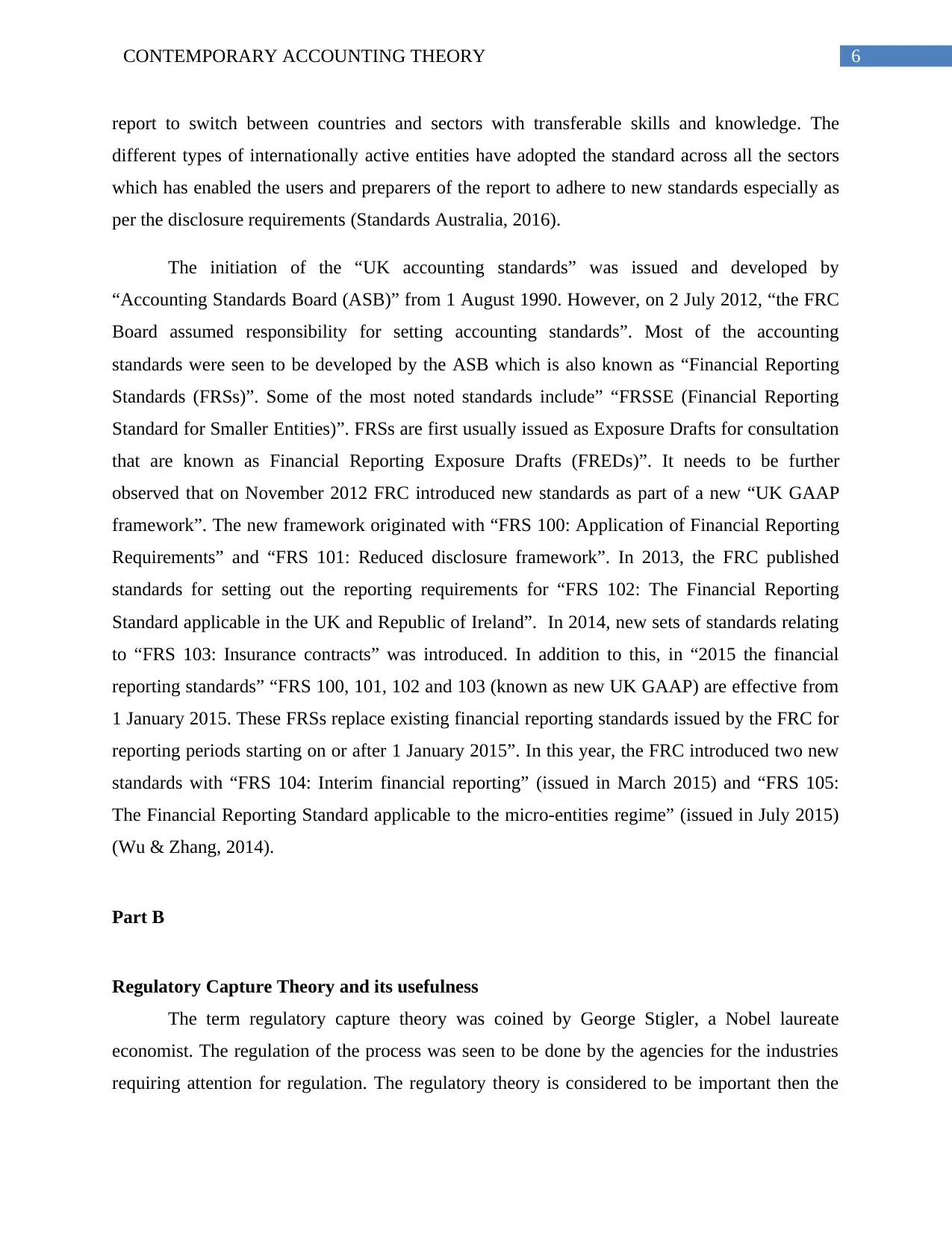
6CONTEMPORARY ACCOUNTING THEORY
report to switch between countries and sectors with transferable skills and knowledge. The
different types of internationally active entities have adopted the standard across all the sectors
which has enabled the users and preparers of the report to adhere to new standards especially as
per the disclosure requirements (Standards Australia, 2016).
The initiation of the “UK accounting standards” was issued and developed by
“Accounting Standards Board (ASB)” from 1 August 1990. However, on 2 July 2012, “the FRC
Board assumed responsibility for setting accounting standards”. Most of the accounting
standards were seen to be developed by the ASB which is also known as “Financial Reporting
Standards (FRSs)”. Some of the most noted standards include” “FRSSE (Financial Reporting
Standard for Smaller Entities)”. FRSs are first usually issued as Exposure Drafts for consultation
that are known as Financial Reporting Exposure Drafts (FREDs)”. It needs to be further
observed that on November 2012 FRC introduced new standards as part of a new “UK GAAP
framework”. The new framework originated with “FRS 100: Application of Financial Reporting
Requirements” and “FRS 101: Reduced disclosure framework”. In 2013, the FRC published
standards for setting out the reporting requirements for “FRS 102: The Financial Reporting
Standard applicable in the UK and Republic of Ireland”. In 2014, new sets of standards relating
to “FRS 103: Insurance contracts” was introduced. In addition to this, in “2015 the financial
reporting standards” “FRS 100, 101, 102 and 103 (known as new UK GAAP) are effective from
1 January 2015. These FRSs replace existing financial reporting standards issued by the FRC for
reporting periods starting on or after 1 January 2015”. In this year, the FRC introduced two new
standards with “FRS 104: Interim financial reporting” (issued in March 2015) and “FRS 105:
The Financial Reporting Standard applicable to the micro-entities regime” (issued in July 2015)
(Wu & Zhang, 2014).
Part B
Regulatory Capture Theory and its usefulness
The term regulatory capture theory was coined by George Stigler, a Nobel laureate
economist. The regulation of the process was seen to be done by the agencies for the industries
requiring attention for regulation. The regulatory theory is considered to be important then the
report to switch between countries and sectors with transferable skills and knowledge. The
different types of internationally active entities have adopted the standard across all the sectors
which has enabled the users and preparers of the report to adhere to new standards especially as
per the disclosure requirements (Standards Australia, 2016).
The initiation of the “UK accounting standards” was issued and developed by
“Accounting Standards Board (ASB)” from 1 August 1990. However, on 2 July 2012, “the FRC
Board assumed responsibility for setting accounting standards”. Most of the accounting
standards were seen to be developed by the ASB which is also known as “Financial Reporting
Standards (FRSs)”. Some of the most noted standards include” “FRSSE (Financial Reporting
Standard for Smaller Entities)”. FRSs are first usually issued as Exposure Drafts for consultation
that are known as Financial Reporting Exposure Drafts (FREDs)”. It needs to be further
observed that on November 2012 FRC introduced new standards as part of a new “UK GAAP
framework”. The new framework originated with “FRS 100: Application of Financial Reporting
Requirements” and “FRS 101: Reduced disclosure framework”. In 2013, the FRC published
standards for setting out the reporting requirements for “FRS 102: The Financial Reporting
Standard applicable in the UK and Republic of Ireland”. In 2014, new sets of standards relating
to “FRS 103: Insurance contracts” was introduced. In addition to this, in “2015 the financial
reporting standards” “FRS 100, 101, 102 and 103 (known as new UK GAAP) are effective from
1 January 2015. These FRSs replace existing financial reporting standards issued by the FRC for
reporting periods starting on or after 1 January 2015”. In this year, the FRC introduced two new
standards with “FRS 104: Interim financial reporting” (issued in March 2015) and “FRS 105:
The Financial Reporting Standard applicable to the micro-entities regime” (issued in July 2015)
(Wu & Zhang, 2014).
Part B
Regulatory Capture Theory and its usefulness
The term regulatory capture theory was coined by George Stigler, a Nobel laureate
economist. The regulation of the process was seen to be done by the agencies for the industries
requiring attention for regulation. The regulatory theory is considered to be important then the
Paraphrase This Document
Need a fresh take? Get an instant paraphrase of this document with our AI Paraphraser
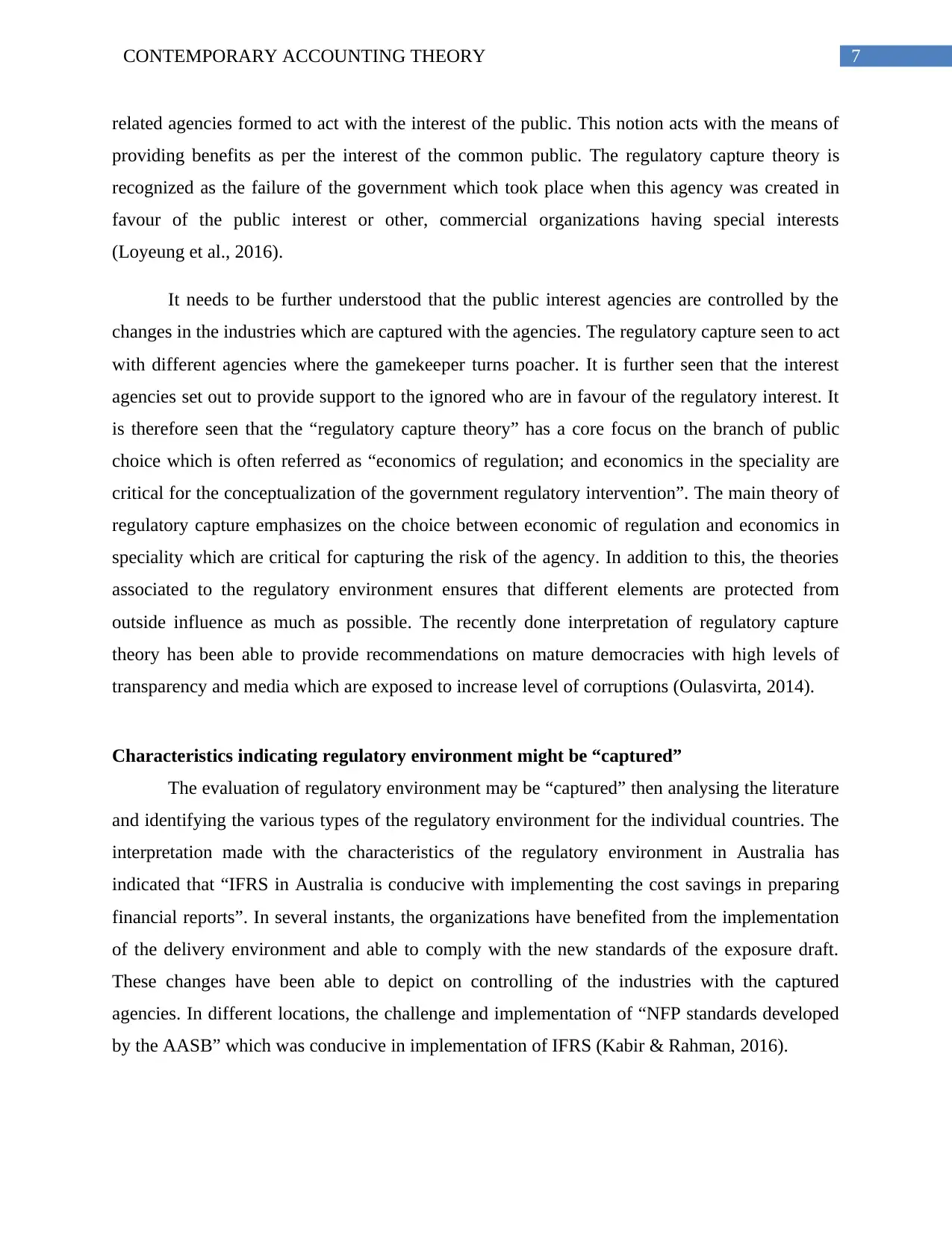
7CONTEMPORARY ACCOUNTING THEORY
related agencies formed to act with the interest of the public. This notion acts with the means of
providing benefits as per the interest of the common public. The regulatory capture theory is
recognized as the failure of the government which took place when this agency was created in
favour of the public interest or other, commercial organizations having special interests
(Loyeung et al., 2016).
It needs to be further understood that the public interest agencies are controlled by the
changes in the industries which are captured with the agencies. The regulatory capture seen to act
with different agencies where the gamekeeper turns poacher. It is further seen that the interest
agencies set out to provide support to the ignored who are in favour of the regulatory interest. It
is therefore seen that the “regulatory capture theory” has a core focus on the branch of public
choice which is often referred as “economics of regulation; and economics in the speciality are
critical for the conceptualization of the government regulatory intervention”. The main theory of
regulatory capture emphasizes on the choice between economic of regulation and economics in
speciality which are critical for capturing the risk of the agency. In addition to this, the theories
associated to the regulatory environment ensures that different elements are protected from
outside influence as much as possible. The recently done interpretation of regulatory capture
theory has been able to provide recommendations on mature democracies with high levels of
transparency and media which are exposed to increase level of corruptions (Oulasvirta, 2014).
Characteristics indicating regulatory environment might be “captured”
The evaluation of regulatory environment may be “captured” then analysing the literature
and identifying the various types of the regulatory environment for the individual countries. The
interpretation made with the characteristics of the regulatory environment in Australia has
indicated that “IFRS in Australia is conducive with implementing the cost savings in preparing
financial reports”. In several instants, the organizations have benefited from the implementation
of the delivery environment and able to comply with the new standards of the exposure draft.
These changes have been able to depict on controlling of the industries with the captured
agencies. In different locations, the challenge and implementation of “NFP standards developed
by the AASB” which was conducive in implementation of IFRS (Kabir & Rahman, 2016).
related agencies formed to act with the interest of the public. This notion acts with the means of
providing benefits as per the interest of the common public. The regulatory capture theory is
recognized as the failure of the government which took place when this agency was created in
favour of the public interest or other, commercial organizations having special interests
(Loyeung et al., 2016).
It needs to be further understood that the public interest agencies are controlled by the
changes in the industries which are captured with the agencies. The regulatory capture seen to act
with different agencies where the gamekeeper turns poacher. It is further seen that the interest
agencies set out to provide support to the ignored who are in favour of the regulatory interest. It
is therefore seen that the “regulatory capture theory” has a core focus on the branch of public
choice which is often referred as “economics of regulation; and economics in the speciality are
critical for the conceptualization of the government regulatory intervention”. The main theory of
regulatory capture emphasizes on the choice between economic of regulation and economics in
speciality which are critical for capturing the risk of the agency. In addition to this, the theories
associated to the regulatory environment ensures that different elements are protected from
outside influence as much as possible. The recently done interpretation of regulatory capture
theory has been able to provide recommendations on mature democracies with high levels of
transparency and media which are exposed to increase level of corruptions (Oulasvirta, 2014).
Characteristics indicating regulatory environment might be “captured”
The evaluation of regulatory environment may be “captured” then analysing the literature
and identifying the various types of the regulatory environment for the individual countries. The
interpretation made with the characteristics of the regulatory environment in Australia has
indicated that “IFRS in Australia is conducive with implementing the cost savings in preparing
financial reports”. In several instants, the organizations have benefited from the implementation
of the delivery environment and able to comply with the new standards of the exposure draft.
These changes have been able to depict on controlling of the industries with the captured
agencies. In different locations, the challenge and implementation of “NFP standards developed
by the AASB” which was conducive in implementation of IFRS (Kabir & Rahman, 2016).
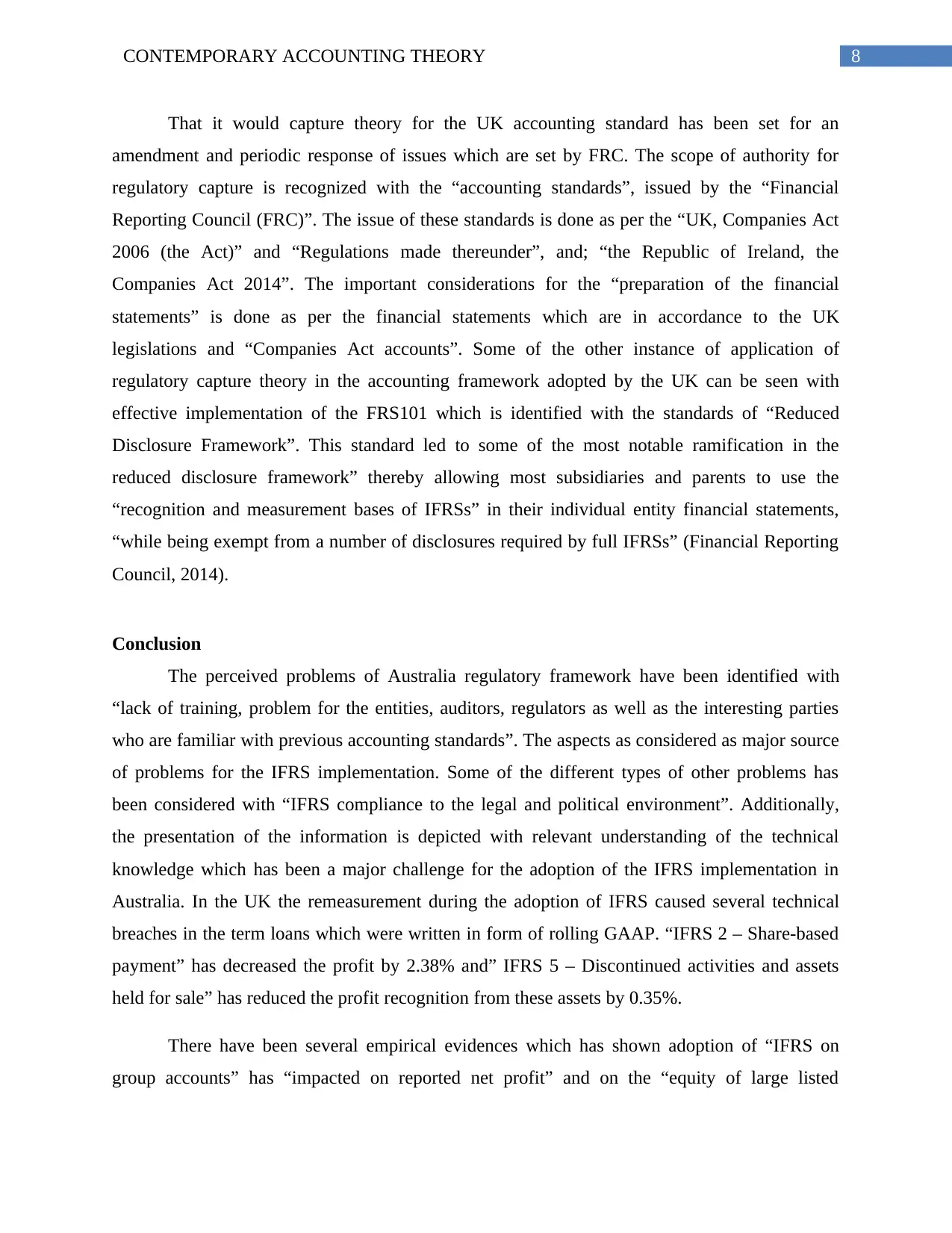
8CONTEMPORARY ACCOUNTING THEORY
That it would capture theory for the UK accounting standard has been set for an
amendment and periodic response of issues which are set by FRC. The scope of authority for
regulatory capture is recognized with the “accounting standards”, issued by the “Financial
Reporting Council (FRC)”. The issue of these standards is done as per the “UK, Companies Act
2006 (the Act)” and “Regulations made thereunder”, and; “the Republic of Ireland, the
Companies Act 2014”. The important considerations for the “preparation of the financial
statements” is done as per the financial statements which are in accordance to the UK
legislations and “Companies Act accounts”. Some of the other instance of application of
regulatory capture theory in the accounting framework adopted by the UK can be seen with
effective implementation of the FRS101 which is identified with the standards of “Reduced
Disclosure Framework”. This standard led to some of the most notable ramification in the
reduced disclosure framework” thereby allowing most subsidiaries and parents to use the
“recognition and measurement bases of IFRSs” in their individual entity financial statements,
“while being exempt from a number of disclosures required by full IFRSs” (Financial Reporting
Council, 2014).
Conclusion
The perceived problems of Australia regulatory framework have been identified with
“lack of training, problem for the entities, auditors, regulators as well as the interesting parties
who are familiar with previous accounting standards”. The aspects as considered as major source
of problems for the IFRS implementation. Some of the different types of other problems has
been considered with “IFRS compliance to the legal and political environment”. Additionally,
the presentation of the information is depicted with relevant understanding of the technical
knowledge which has been a major challenge for the adoption of the IFRS implementation in
Australia. In the UK the remeasurement during the adoption of IFRS caused several technical
breaches in the term loans which were written in form of rolling GAAP. “IFRS 2 – Share-based
payment” has decreased the profit by 2.38% and” IFRS 5 – Discontinued activities and assets
held for sale” has reduced the profit recognition from these assets by 0.35%.
There have been several empirical evidences which has shown adoption of “IFRS on
group accounts” has “impacted on reported net profit” and on the “equity of large listed
That it would capture theory for the UK accounting standard has been set for an
amendment and periodic response of issues which are set by FRC. The scope of authority for
regulatory capture is recognized with the “accounting standards”, issued by the “Financial
Reporting Council (FRC)”. The issue of these standards is done as per the “UK, Companies Act
2006 (the Act)” and “Regulations made thereunder”, and; “the Republic of Ireland, the
Companies Act 2014”. The important considerations for the “preparation of the financial
statements” is done as per the financial statements which are in accordance to the UK
legislations and “Companies Act accounts”. Some of the other instance of application of
regulatory capture theory in the accounting framework adopted by the UK can be seen with
effective implementation of the FRS101 which is identified with the standards of “Reduced
Disclosure Framework”. This standard led to some of the most notable ramification in the
reduced disclosure framework” thereby allowing most subsidiaries and parents to use the
“recognition and measurement bases of IFRSs” in their individual entity financial statements,
“while being exempt from a number of disclosures required by full IFRSs” (Financial Reporting
Council, 2014).
Conclusion
The perceived problems of Australia regulatory framework have been identified with
“lack of training, problem for the entities, auditors, regulators as well as the interesting parties
who are familiar with previous accounting standards”. The aspects as considered as major source
of problems for the IFRS implementation. Some of the different types of other problems has
been considered with “IFRS compliance to the legal and political environment”. Additionally,
the presentation of the information is depicted with relevant understanding of the technical
knowledge which has been a major challenge for the adoption of the IFRS implementation in
Australia. In the UK the remeasurement during the adoption of IFRS caused several technical
breaches in the term loans which were written in form of rolling GAAP. “IFRS 2 – Share-based
payment” has decreased the profit by 2.38% and” IFRS 5 – Discontinued activities and assets
held for sale” has reduced the profit recognition from these assets by 0.35%.
There have been several empirical evidences which has shown adoption of “IFRS on
group accounts” has “impacted on reported net profit” and on the “equity of large listed
⊘ This is a preview!⊘
Do you want full access?
Subscribe today to unlock all pages.

Trusted by 1+ million students worldwide
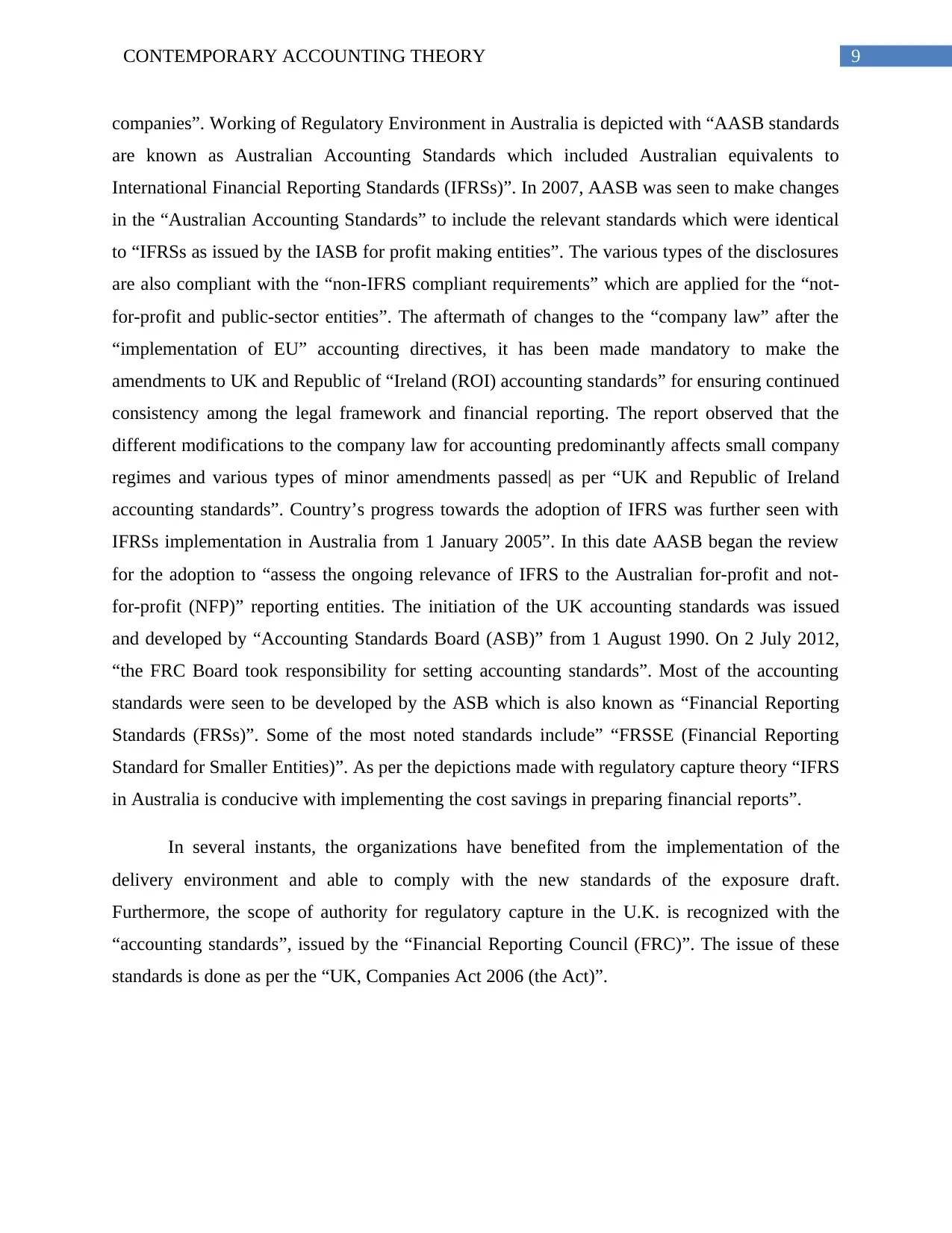
9CONTEMPORARY ACCOUNTING THEORY
companies”. Working of Regulatory Environment in Australia is depicted with “AASB standards
are known as Australian Accounting Standards which included Australian equivalents to
International Financial Reporting Standards (IFRSs)”. In 2007, AASB was seen to make changes
in the “Australian Accounting Standards” to include the relevant standards which were identical
to “IFRSs as issued by the IASB for profit making entities”. The various types of the disclosures
are also compliant with the “non-IFRS compliant requirements” which are applied for the “not-
for-profit and public-sector entities”. The aftermath of changes to the “company law” after the
“implementation of EU” accounting directives, it has been made mandatory to make the
amendments to UK and Republic of “Ireland (ROI) accounting standards” for ensuring continued
consistency among the legal framework and financial reporting. The report observed that the
different modifications to the company law for accounting predominantly affects small company
regimes and various types of minor amendments passed| as per “UK and Republic of Ireland
accounting standards”. Country’s progress towards the adoption of IFRS was further seen with
IFRSs implementation in Australia from 1 January 2005”. In this date AASB began the review
for the adoption to “assess the ongoing relevance of IFRS to the Australian for-profit and not-
for-profit (NFP)” reporting entities. The initiation of the UK accounting standards was issued
and developed by “Accounting Standards Board (ASB)” from 1 August 1990. On 2 July 2012,
“the FRC Board took responsibility for setting accounting standards”. Most of the accounting
standards were seen to be developed by the ASB which is also known as “Financial Reporting
Standards (FRSs)”. Some of the most noted standards include” “FRSSE (Financial Reporting
Standard for Smaller Entities)”. As per the depictions made with regulatory capture theory “IFRS
in Australia is conducive with implementing the cost savings in preparing financial reports”.
In several instants, the organizations have benefited from the implementation of the
delivery environment and able to comply with the new standards of the exposure draft.
Furthermore, the scope of authority for regulatory capture in the U.K. is recognized with the
“accounting standards”, issued by the “Financial Reporting Council (FRC)”. The issue of these
standards is done as per the “UK, Companies Act 2006 (the Act)”.
companies”. Working of Regulatory Environment in Australia is depicted with “AASB standards
are known as Australian Accounting Standards which included Australian equivalents to
International Financial Reporting Standards (IFRSs)”. In 2007, AASB was seen to make changes
in the “Australian Accounting Standards” to include the relevant standards which were identical
to “IFRSs as issued by the IASB for profit making entities”. The various types of the disclosures
are also compliant with the “non-IFRS compliant requirements” which are applied for the “not-
for-profit and public-sector entities”. The aftermath of changes to the “company law” after the
“implementation of EU” accounting directives, it has been made mandatory to make the
amendments to UK and Republic of “Ireland (ROI) accounting standards” for ensuring continued
consistency among the legal framework and financial reporting. The report observed that the
different modifications to the company law for accounting predominantly affects small company
regimes and various types of minor amendments passed| as per “UK and Republic of Ireland
accounting standards”. Country’s progress towards the adoption of IFRS was further seen with
IFRSs implementation in Australia from 1 January 2005”. In this date AASB began the review
for the adoption to “assess the ongoing relevance of IFRS to the Australian for-profit and not-
for-profit (NFP)” reporting entities. The initiation of the UK accounting standards was issued
and developed by “Accounting Standards Board (ASB)” from 1 August 1990. On 2 July 2012,
“the FRC Board took responsibility for setting accounting standards”. Most of the accounting
standards were seen to be developed by the ASB which is also known as “Financial Reporting
Standards (FRSs)”. Some of the most noted standards include” “FRSSE (Financial Reporting
Standard for Smaller Entities)”. As per the depictions made with regulatory capture theory “IFRS
in Australia is conducive with implementing the cost savings in preparing financial reports”.
In several instants, the organizations have benefited from the implementation of the
delivery environment and able to comply with the new standards of the exposure draft.
Furthermore, the scope of authority for regulatory capture in the U.K. is recognized with the
“accounting standards”, issued by the “Financial Reporting Council (FRC)”. The issue of these
standards is done as per the “UK, Companies Act 2006 (the Act)”.
Paraphrase This Document
Need a fresh take? Get an instant paraphrase of this document with our AI Paraphraser
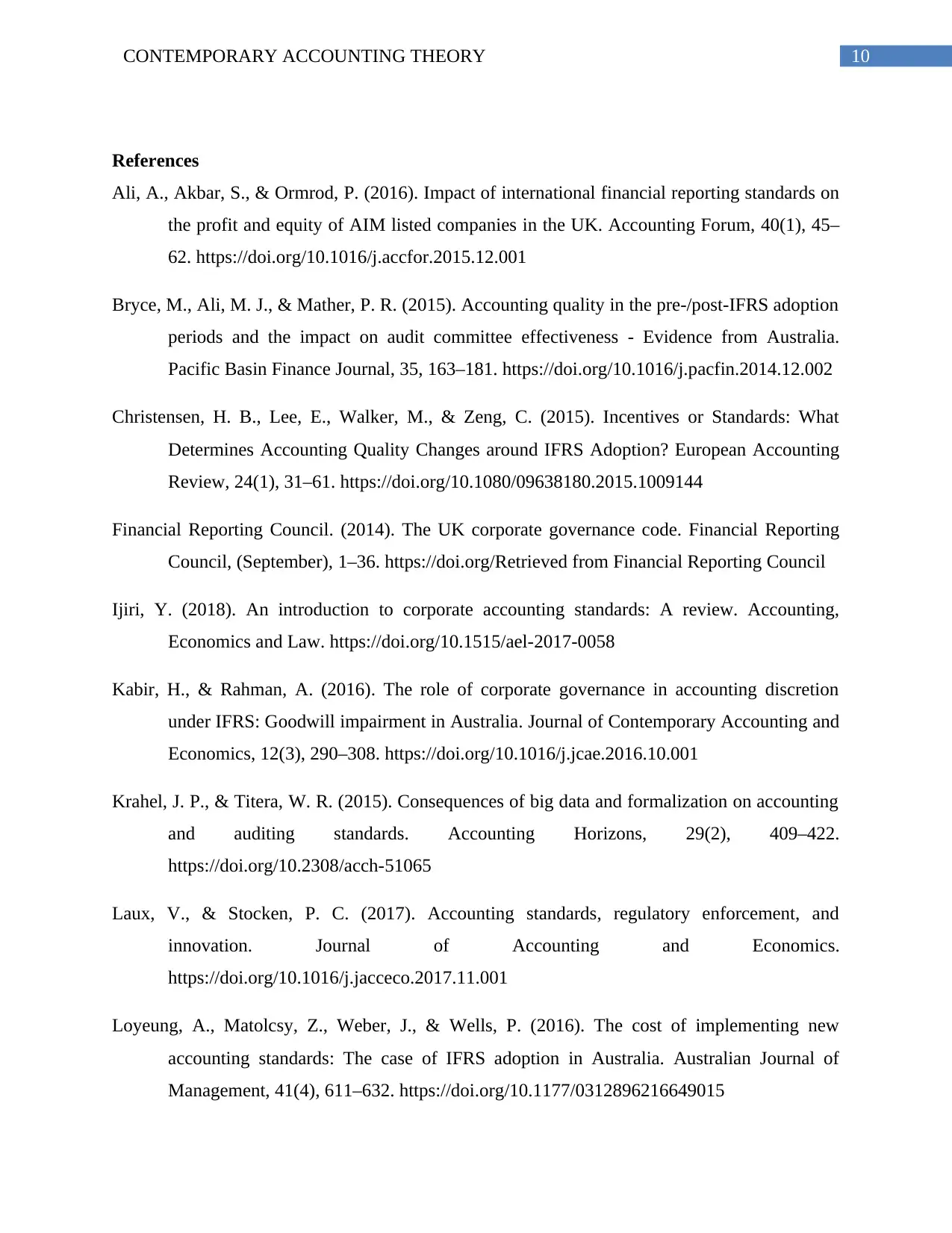
10CONTEMPORARY ACCOUNTING THEORY
References
Ali, A., Akbar, S., & Ormrod, P. (2016). Impact of international financial reporting standards on
the profit and equity of AIM listed companies in the UK. Accounting Forum, 40(1), 45–
62. https://doi.org/10.1016/j.accfor.2015.12.001
Bryce, M., Ali, M. J., & Mather, P. R. (2015). Accounting quality in the pre-/post-IFRS adoption
periods and the impact on audit committee effectiveness - Evidence from Australia.
Pacific Basin Finance Journal, 35, 163–181. https://doi.org/10.1016/j.pacfin.2014.12.002
Christensen, H. B., Lee, E., Walker, M., & Zeng, C. (2015). Incentives or Standards: What
Determines Accounting Quality Changes around IFRS Adoption? European Accounting
Review, 24(1), 31–61. https://doi.org/10.1080/09638180.2015.1009144
Financial Reporting Council. (2014). The UK corporate governance code. Financial Reporting
Council, (September), 1–36. https://doi.org/Retrieved from Financial Reporting Council
Ijiri, Y. (2018). An introduction to corporate accounting standards: A review. Accounting,
Economics and Law. https://doi.org/10.1515/ael-2017-0058
Kabir, H., & Rahman, A. (2016). The role of corporate governance in accounting discretion
under IFRS: Goodwill impairment in Australia. Journal of Contemporary Accounting and
Economics, 12(3), 290–308. https://doi.org/10.1016/j.jcae.2016.10.001
Krahel, J. P., & Titera, W. R. (2015). Consequences of big data and formalization on accounting
and auditing standards. Accounting Horizons, 29(2), 409–422.
https://doi.org/10.2308/acch-51065
Laux, V., & Stocken, P. C. (2017). Accounting standards, regulatory enforcement, and
innovation. Journal of Accounting and Economics.
https://doi.org/10.1016/j.jacceco.2017.11.001
Loyeung, A., Matolcsy, Z., Weber, J., & Wells, P. (2016). The cost of implementing new
accounting standards: The case of IFRS adoption in Australia. Australian Journal of
Management, 41(4), 611–632. https://doi.org/10.1177/0312896216649015
References
Ali, A., Akbar, S., & Ormrod, P. (2016). Impact of international financial reporting standards on
the profit and equity of AIM listed companies in the UK. Accounting Forum, 40(1), 45–
62. https://doi.org/10.1016/j.accfor.2015.12.001
Bryce, M., Ali, M. J., & Mather, P. R. (2015). Accounting quality in the pre-/post-IFRS adoption
periods and the impact on audit committee effectiveness - Evidence from Australia.
Pacific Basin Finance Journal, 35, 163–181. https://doi.org/10.1016/j.pacfin.2014.12.002
Christensen, H. B., Lee, E., Walker, M., & Zeng, C. (2015). Incentives or Standards: What
Determines Accounting Quality Changes around IFRS Adoption? European Accounting
Review, 24(1), 31–61. https://doi.org/10.1080/09638180.2015.1009144
Financial Reporting Council. (2014). The UK corporate governance code. Financial Reporting
Council, (September), 1–36. https://doi.org/Retrieved from Financial Reporting Council
Ijiri, Y. (2018). An introduction to corporate accounting standards: A review. Accounting,
Economics and Law. https://doi.org/10.1515/ael-2017-0058
Kabir, H., & Rahman, A. (2016). The role of corporate governance in accounting discretion
under IFRS: Goodwill impairment in Australia. Journal of Contemporary Accounting and
Economics, 12(3), 290–308. https://doi.org/10.1016/j.jcae.2016.10.001
Krahel, J. P., & Titera, W. R. (2015). Consequences of big data and formalization on accounting
and auditing standards. Accounting Horizons, 29(2), 409–422.
https://doi.org/10.2308/acch-51065
Laux, V., & Stocken, P. C. (2017). Accounting standards, regulatory enforcement, and
innovation. Journal of Accounting and Economics.
https://doi.org/10.1016/j.jacceco.2017.11.001
Loyeung, A., Matolcsy, Z., Weber, J., & Wells, P. (2016). The cost of implementing new
accounting standards: The case of IFRS adoption in Australia. Australian Journal of
Management, 41(4), 611–632. https://doi.org/10.1177/0312896216649015
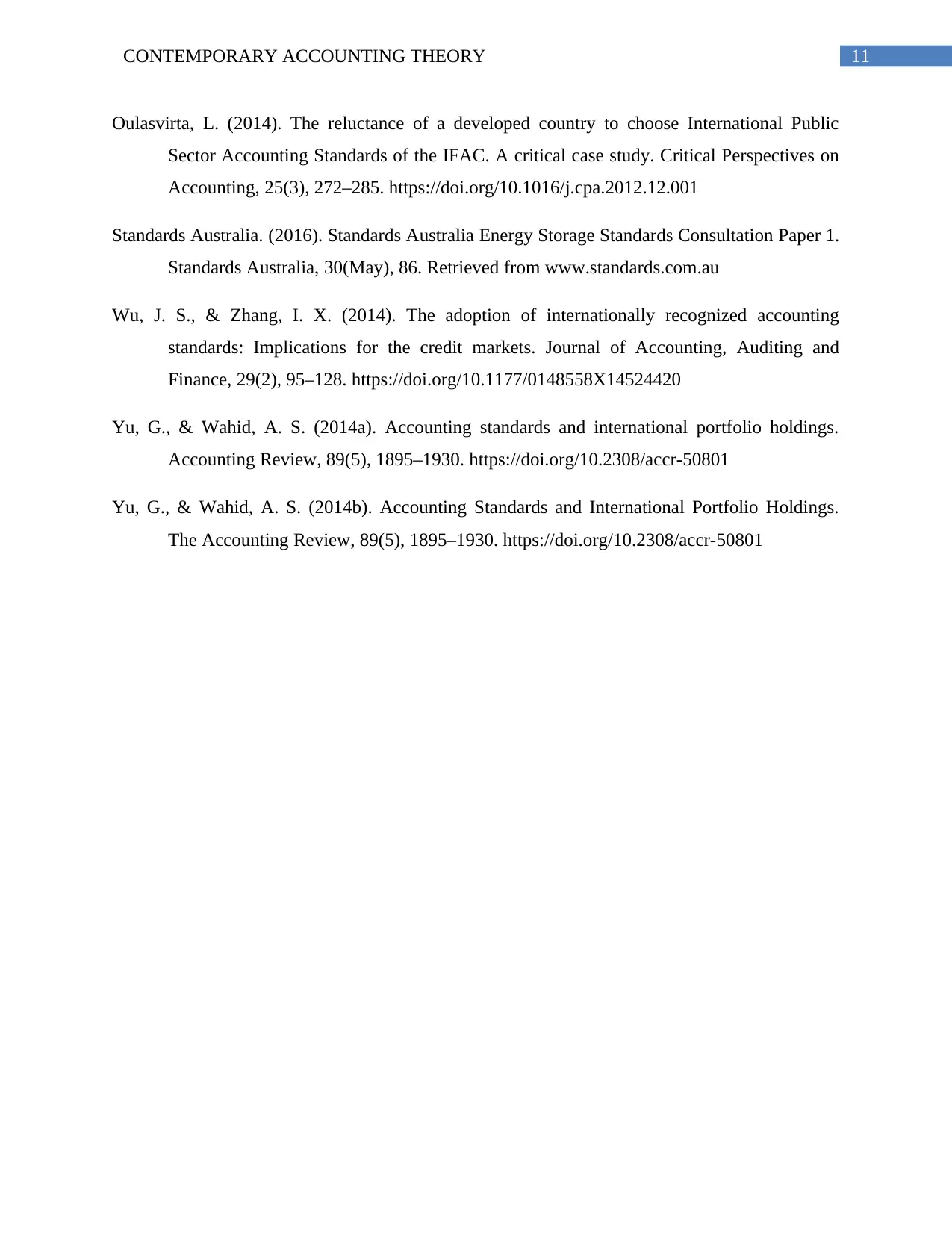
11CONTEMPORARY ACCOUNTING THEORY
Oulasvirta, L. (2014). The reluctance of a developed country to choose International Public
Sector Accounting Standards of the IFAC. A critical case study. Critical Perspectives on
Accounting, 25(3), 272–285. https://doi.org/10.1016/j.cpa.2012.12.001
Standards Australia. (2016). Standards Australia Energy Storage Standards Consultation Paper 1.
Standards Australia, 30(May), 86. Retrieved from www.standards.com.au
Wu, J. S., & Zhang, I. X. (2014). The adoption of internationally recognized accounting
standards: Implications for the credit markets. Journal of Accounting, Auditing and
Finance, 29(2), 95–128. https://doi.org/10.1177/0148558X14524420
Yu, G., & Wahid, A. S. (2014a). Accounting standards and international portfolio holdings.
Accounting Review, 89(5), 1895–1930. https://doi.org/10.2308/accr-50801
Yu, G., & Wahid, A. S. (2014b). Accounting Standards and International Portfolio Holdings.
The Accounting Review, 89(5), 1895–1930. https://doi.org/10.2308/accr-50801
Oulasvirta, L. (2014). The reluctance of a developed country to choose International Public
Sector Accounting Standards of the IFAC. A critical case study. Critical Perspectives on
Accounting, 25(3), 272–285. https://doi.org/10.1016/j.cpa.2012.12.001
Standards Australia. (2016). Standards Australia Energy Storage Standards Consultation Paper 1.
Standards Australia, 30(May), 86. Retrieved from www.standards.com.au
Wu, J. S., & Zhang, I. X. (2014). The adoption of internationally recognized accounting
standards: Implications for the credit markets. Journal of Accounting, Auditing and
Finance, 29(2), 95–128. https://doi.org/10.1177/0148558X14524420
Yu, G., & Wahid, A. S. (2014a). Accounting standards and international portfolio holdings.
Accounting Review, 89(5), 1895–1930. https://doi.org/10.2308/accr-50801
Yu, G., & Wahid, A. S. (2014b). Accounting Standards and International Portfolio Holdings.
The Accounting Review, 89(5), 1895–1930. https://doi.org/10.2308/accr-50801
⊘ This is a preview!⊘
Do you want full access?
Subscribe today to unlock all pages.

Trusted by 1+ million students worldwide
1 out of 12
Related Documents
Your All-in-One AI-Powered Toolkit for Academic Success.
+13062052269
info@desklib.com
Available 24*7 on WhatsApp / Email
![[object Object]](/_next/static/media/star-bottom.7253800d.svg)
Unlock your academic potential
Copyright © 2020–2025 A2Z Services. All Rights Reserved. Developed and managed by ZUCOL.




